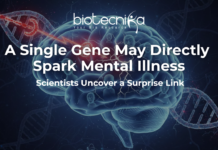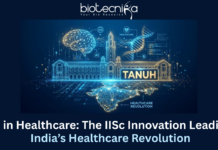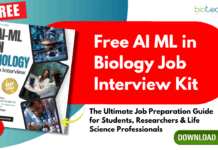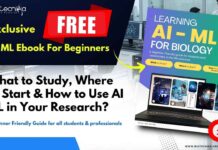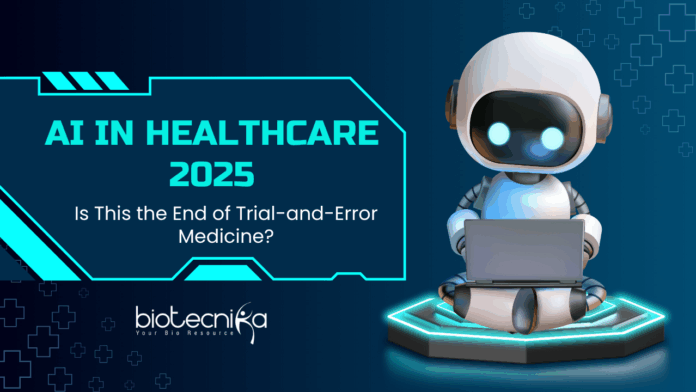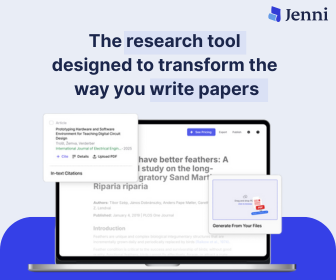AI in Healthcare 2025: Is This the End of Trial-and-Error Medicine?
Just a few years ago, AI was a buzzword. Today, it’s sitting in the operating room, the research lab, and even at the bedside. This quiet transformation is changing the way we understand diseases, drug development, and deliver care. This is not sci-fi. This is the new reality of medicine.
AI is not replacing doctors. AI in Healthcare 2025 is encouraging them to think differently, work more intelligently, and embrace a new kind of partner in care. The pattern is made of code.
AI is reshaping medicine faster than any textbook ever could. From predicting protein structure to writing clinical notes in real-time, AI is a genuine game-changer.
But this transformation is not just about algorithms. It’s about reimagining the definition of what AI means to be a doctor in this digital era.
One such example of AI’s growing potential has come from Dr. Lloyd B. Minor. He is a surgeon and Dean of the Stanford School of Medicine.
A few years ago, Minor asked ChatGPT about a rare inner ear disorder, superior canal dehiscence syndrome, a condition he discovered and wrote the first paper on. The response he got? Concise, logical, and impressively accurate.
Mr. Minor said that the way AI assimilated the information and presented it was pretty remarkable. And that’s when he realized that this is not just an incremental advance. There is a shift in the core of medicine.
AI in Medical Research: From AlphaFold to AlphaGenome
AI’s most profound impact to date has been in the field of medical research. Released in 2020, Google DeepMind’s AlphaFold2 has cracked one of life science’s biggest mysteries. That was protein folding.
AlphaFold2 has predicted nearly 200 million known protein structures. This has saved researchers decades of time and effort.
Used by over 2 million scientists in 190 countries, AlphaFold2’s influence has been so profound that it helped spark a biotech boom and earned DeepMind’s researchers a Nobel Prize.
Building on this momentum, AI-designed drugs are now entering clinical trials. A treatment for idiopathic pulmonary fibrosis, developed by Insilico Medicine using AI, entered Phase II trials last year. Although no AI-generated drug has yet reached pharmacies, the process of discovering and developing treatments has become dramatically faster and more efficient.
And the momentum doesn’t stop with drug design. AI tools are now outperforming traditional tests in predicting disease progression. Researchers at Cambridge University have developed a model that forecasts Alzheimer’s progression with greater accuracy than standard clinical approaches. Harvard researchers have shown similar success with multi-cancer detection and survival prediction models.
Google DeepMind’s AlphaGenome was introduced most recently. This tool is designed to predict the impact of individual DNA mutations on gene regulation. With this one tool, a wide range of opportunities in genetic research and personalized medicine are opened.
A Better Day at the Doctor’s Office
AI isn’t just transforming what happens in research labs. It’s reshaping everyday experiences for physicians and patients. According to Wiljeana Glover, a healthcare innovation expert at Babson College, AI is proving most valuable in administrative and backend processes.
Emergency departments, for example, now utilize AI-powered tools to summarize patient records and transcribe doctor-patient conversations, freeing doctors from their screens and allowing them to focus on patients.
A 2020 study revealed that doctors spend over a third of their work time on paperwork. This often spills into their hours. Due to this, they tend to hamper their work-life balance. By automating the paperwork, there will be a reduction in burnout and an improvement in productivity. This will also enhance patient care by allowing the doctors more face-to-face interactions.
Physicians are also utilizing AI to make more informed clinical decisions. LLMs (Large Language Models) enable them to access medical literature and treatment options quickly. Most importantly, in complex cases.
Wearables and AI-driven health apps are being integrated into the care of chronic diseases, such as hypertension and diabetes. They provide clinicians with real-time insights into a patient’s condition and lifestyle.
In radiology, AI has become a daily partner. It‘s being used to enhance image quality, flag abnormalities, and highlight minute changes that human eyes might miss.
One system from Northwestern University even outperformed expert pathologists in predicting breast cancer outcomes, raising the potential for more tailored and less aggressive treatments.
Training the Next Gen of AI-Literate Doctors
AI is not just influencing doctors’ workflow. It is reshaping how they are trained. Medical schools across the US are starting to redesign their curricula to keep pace with the growing influence of generative AI in healthcare 2025.
George Washington University’s School of Medicine will offer a new course this fall on AI in healthcare, while the Icahn School of Medicine at Mount Sinai is providing students with ChatGPT Edu and training on its responsible use.
At Stanford, Minor and his team are exploring how to blend traditional medical knowledge with AI literacy. He said that they don’t want to abandon core medical knowledge. But they do need to define what’s essential now and in the future. And that requires thoughtful redesigning.
Meanwhile, researchers at institutions like the New Jersey Institute of Technology are developing AI-powered simulators that aid medical students in practicing surgical skills.
These systems offer feedback that rivals. Sometimes surpasses that of seasoned instructors, helping students refine their techniques in real-time.
Proceeding with Caution
Despite the breakthroughs, experts are clear-eyed about the risks.
Drug development still relies heavily on “wet lab” work, physical experimentation, and rigorous clinical trials. AI may accelerate candidate discovery, but safety and efficacy must be proven the old-fashioned way. Likewise, documentation tools from companies like Abridge and Microsoft’s Nuance, while promising, carry risks of misinformation or “hallucinated” facts.
Perhaps most concerning is AI’s historical bias. Diagnostic algorithms often underperform for women and people of color due to limited representation in training data. And as patient data fuels AI model development, privacy concerns loom large.
“I think we’re moving cautiously, and I think the caution is ideal,” said Glover. “But absolutely, the way patients seek, reach, and receive care will be impacted by AI. It’s happening. It’s here.”
The Future Is Now
AI in healthcare is no longer a question of “if”. It’s now “how soon” and “how responsibly.” The medical field is at a crossroads, rimming with potential yet lined with caution tape.
From ground-breaking research and personalized treatments to streamlined clinical workflows and training tools, the transformation has begun. As we navigate the promises and pitfalls of AI in Healthcare 2025, striking the right balance between innovation, ethics, and human touch will be crucial.


